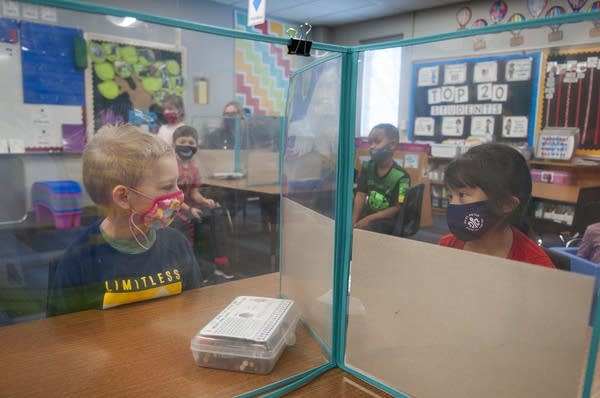Survey: Minnesotans of color less likely to believe schools offer equal opportunities

Go Deeper.
Create an account or log in to save stories.
Like this?
Thanks for liking this story! We have added it to a list of your favorite stories.
White Minnesotans think very differently about the opportunities that the state’s K-12 public schools provide to all students than Minnesotans of color, according to a newly released survey from the APM Research Lab.
Black Minnesotans were the least likely to say Black children have the same opportunities as their white peers. Only 15 percent of Black Minnesotans, as compared to 48 percent of white Minnesotans, believed all children have the same opportunities, regardless of racial and ethnic background.
“There’s just universal underserving of the people of color communities across the board. That’s historical throughout the country as far as having a segregated community,” said Edric Knight, a retired CPA who is Black. Knight has lived in Minnesota and mentored students in the state.
He points to a history of racial segregation and the state’s school funding system as reasons why educational opportunities are so unequal.
Turn Up Your Support
MPR News helps you turn down the noise and build shared understanding. Turn up your support for this public resource and keep trusted journalism accessible to all.
“The funding goes to the whites, so if you’re not close to the whites, you’re not going to get access to that funding. And that’s the problem,” Knight said.
The survey, conducted from April 26 to June 14, asked 1,532 Minnesotans a variety of questions, including about their attitudes toward the state’s K-12 public schools.
While a majority of Minnesotans — 56 percent — indicated that they trust schools in the state to do what is right either “just about always” or “most of the time,” more than a third agreed with Knight that they “never” or “only some of the time” trust schools.
Minnesota’s history of segregation and discrimination in lending known as redlining may be why survey respondents of different races and ethnicities have such drastically different views on public education.
Jessica Calarco, associate professor of sociology at Indiana University, said Minnesota’s not alone.
“In most states across the country, schools are extremely segregated by race and ethnicity and also by socioeconomic status,” Calarco says. “So when parents are thinking about their own white kids compared to students of color, they’re only thinking about the handfuls of students of color who are in their schools. And they’re thinking, ‘My kid is getting the same opportunities as that kid is and so everything is equal.’ What they’re ignoring in many cases is the fact that there are deep inequalities across different communities and across different schools.”
“School funding is based on property taxes and so because of that it’s inherently unequal,” said Jenny Shorter, a special education paraprofessional in Sartell, Minn., who is white.
Shorter’s experience with diverse groups of students has shaped her understanding of Minnesota’s education system. But she’s also taken the time to read and learn about the way the education system is funded and structured.
Indigenous Minnesotans have the lowest trust levels in the state’s K-12 schools. And Hmong survey respondents were less likely than other Asian Americans participating in the survey to believe Minnesota’s public schools offer children equal opportunities just about always or most of the time.
Mee Moua, 36, and a resident of St. Paul, said Minnesota schools are inconsistent in offering equal opportunities to Hmong children.
“I’ve seen both good and bad,” Moua said. “Being a person of color you see that you don’t get some advantages. But I wouldn’t complain too much. It’s been fair.”
Moua has four children who’ve gone through Minnesota schools. She graduated from a St. Paul public school. Her parents were refugees, and she said that sometimes made it difficult for her to participate in the same opportunities as her white classmates.
She said she often had to help interpret or translate things for her parents, who weren’t always able to advocate for her and her siblings.
“I can see when it comes to advantages or programs, or even grants or scholarships, I don’t see as many Asian kids get recognized or acknowledged,” Moua said.
More Hmong language and history courses would help. A curriculum centered on white experiences failed to give students knowledge of other cultures, Moua added.
Race and ethnicity are not the only factors that influence opinions on the equality of Minnesota’s education system; politics, geography and educational attainment also play a role. Republicans were three times more likely than Democrats to say they thought all children had the same opportunities in Minnesota schools.
More than half of respondents from greater Minnesota thought children had equal educational opportunities, whereas 35 percent of Twin Cities residents thought the same way. Only 28 percent of those who graduated from college thought Minnesota schools offered equal opportunities, compared to 45 percent of those who had some college-level education.
Correction (Sept. 27, 2021): A previous version of this story misstated Edric Knight's occupation. The article has been updated.



